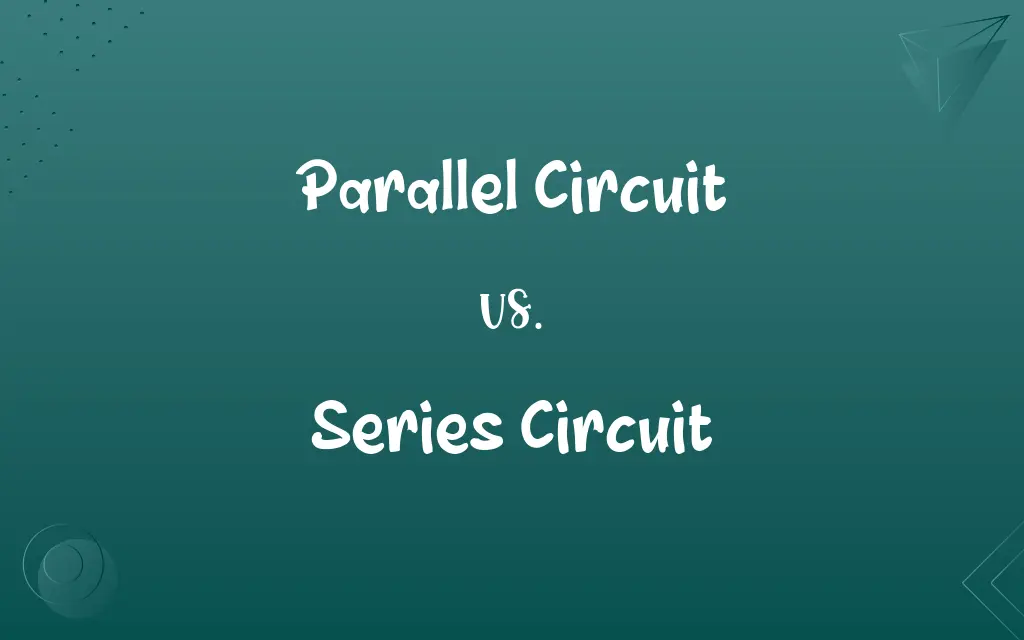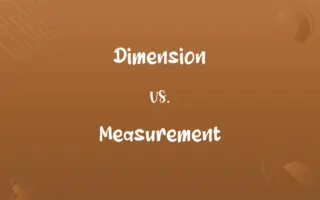Parallel Circuit vs. Series Circuit: Know the Difference

By Shumaila Saeed || Updated on December 25, 2023
In a parallel circuit, components are connected across common points, offering multiple paths for current, whereas in a series circuit, components are connected end-to-end, forming a single path.

Key Differences
Parallel circuits and series circuits are two fundamental ways of arranging electrical components. In a parallel circuit, components like resistors are connected across common points, providing multiple pathways for the electrical current. In contrast, a series circuit connects components end-to-end in a single path, so the same current flows through each component.
Shumaila Saeed
Dec 14, 2023
Voltage distribution differs significantly between these two types of circuits. In a parallel circuit, the voltage across each component is the same as the source voltage, leading to consistent performance across all components. On the other hand, in a series circuit, the voltage is divided among the components, with each component receiving a fraction of the total voltage.
Shumaila Saeed
Dec 14, 2023
The behavior of these circuits under component failure also varies. In a parallel circuit, if one component fails, the rest can continue to operate, as the current can flow through alternate paths. However, in a series circuit, the failure of one component leads to the failure of the entire circuit, as it interrupts the single current path.
Shumaila Saeed
Dec 14, 2023
Current distribution in these circuits is another point of difference. In parallel circuits, the total current is divided among the parallel branches, with each branch carrying a fraction of the total current. In series circuits, the same current flows through all components, as there's only one path for current flow.
Shumaila Saeed
Dec 14, 2023
Regarding practical applications, parallel circuits are commonly used in home wiring systems, allowing appliances to operate independently. Series circuits are often found in simpler devices, like string lights, where the same current is desired through each bulb.
Shumaila Saeed
Dec 14, 2023
ADVERTISEMENT
Comparison Chart
Path for Current Flow
Offers multiple paths for current.
Provides a single path for current.
Shumaila Saeed
Dec 14, 2023
Voltage Distribution
Voltage across each component is the same.
Voltage is divided among the components.
Shumaila Saeed
Dec 14, 2023
Failure of Components
One component's failure doesn't affect others.
Failure of one component affects the whole circuit.
Shumaila Saeed
Dec 14, 2023
Current Distribution
Current is divided among branches.
Same current flows through all components.
Shumaila Saeed
Dec 14, 2023
Practical Applications
Used in home wiring for independent operation.
Found in simpler devices like string lights.
Shumaila Saeed
Dec 14, 2023
ADVERTISEMENT
Parallel Circuit and Series Circuit Definitions
Parallel Circuit
In parallel circuits, the voltage across each branch is equal to the source voltage.
Each bulb in a parallel circuit receives the full voltage.
Shumaila Saeed
Dec 09, 2023
Series Circuit
The failure of one component in a series circuit disrupts the entire circuit.
The Christmas lights are wired in series, so checking each bulb is necessary.
Shumaila Saeed
Dec 09, 2023
Parallel Circuit
Parallel circuits allow components to function independently of each other.
If one light goes out in a parallel circuit, the others remain lit.
Shumaila Saeed
Dec 09, 2023
Series Circuit
Series circuits divide the total voltage among connected components.
Each component in a series circuit gets a fraction of the total voltage.
Shumaila Saeed
Dec 09, 2023
Parallel Circuit
These circuits divide the total current among the various branches.
Parallel circuits are efficient in managing current distribution.
Shumaila Saeed
Dec 09, 2023
ADVERTISEMENT
Series Circuit
Series circuits are simpler and often used in basic electronic devices.
Many old-fashioned holiday lights are designed as series circuits.
Shumaila Saeed
Dec 09, 2023
Parallel Circuit
Parallel circuits are commonly used in residential and commercial wiring.
Parallel circuits in buildings allow for individual control of electrical devices.
Shumaila Saeed
Dec 09, 2023
Series Circuit
A series circuit connects components in a single path, with the same current through each.
In a series circuit, if one bulb fails, the entire string of lights goes out.
Shumaila Saeed
Dec 09, 2023
Parallel Circuit
A parallel circuit has components connected across common points, creating multiple paths.
The house lights are on a parallel circuit, so they operate independently.
Shumaila Saeed
Dec 09, 2023
Series Circuit
In series circuits, the total resistance is the sum of individual resistances.
Adding more bulbs to a series circuit increases its total resistance.
Shumaila Saeed
Dec 09, 2023
Repeatedly Asked Queries
What is the main characteristic of a parallel circuit?
It allows multiple paths for current flow.
Shumaila Saeed
Dec 14, 2023
Are parallel circuits used in home wiring?
Yes, they allow independent operation of appliances.
Shumaila Saeed
Dec 14, 2023
How is voltage divided in a series circuit?
It's split among the connected components.
Shumaila Saeed
Dec 14, 2023
How does voltage distribution work in a parallel circuit?
Each component receives the full source voltage.
Shumaila Saeed
Dec 14, 2023
How does current flow in a parallel circuit?
Current is divided among the different branches.
Shumaila Saeed
Dec 14, 2023
What happens in a parallel circuit if one component fails?
The other components continue to function.
Shumaila Saeed
Dec 14, 2023
What happens if a component in a series circuit fails?
The entire circuit stops functioning.
Shumaila Saeed
Dec 14, 2023
Are series circuits found in simple electronic devices?
Yes, particularly in devices like string lights.
Shumaila Saeed
Dec 14, 2023
What is a key feature of a series circuit?
It has a single path for current flow.
Shumaila Saeed
Dec 14, 2023
Are series circuits suitable for devices needing uniform voltage?
Yes, as the same current flows through each component.
Shumaila Saeed
Dec 14, 2023
Can adding more components in parallel circuits affect voltage?
No, each component still gets the full voltage.
Shumaila Saeed
Dec 14, 2023
How does resistance work in a series circuit?
Total resistance is the sum of individual resistances.
Shumaila Saeed
Dec 14, 2023
How does adding a component in a series circuit affect resistance?
It increases the total resistance of the circuit.
Shumaila Saeed
Dec 14, 2023
Why do lights in series go out if one bulb fails?
Because it interrupts the single path of current flow.
Shumaila Saeed
Dec 14, 2023
Can a parallel circuit operate if one branch is disconnected?
Yes, the other branches remain functional.
Shumaila Saeed
Dec 14, 2023
Is it easier to troubleshoot parallel or series circuits?
Parallel circuits, as components operate independently.
Shumaila Saeed
Dec 14, 2023
Do all components in a series circuit have the same current?
Yes, the current is consistent through all components.
Shumaila Saeed
Dec 14, 2023
Can parallel circuits handle more load than series?
Generally, yes, due to multiple current paths.
Shumaila Saeed
Dec 14, 2023
Do parallel circuits affect battery life differently than series circuits?
Yes, they can be more efficient in power usage.
Shumaila Saeed
Dec 14, 2023
What's safer for residential use, parallel or series circuits?
Parallel circuits, due to their independent operation.
Shumaila Saeed
Dec 14, 2023
Share this page
Link for your blog / website
HTML
Link to share via messenger
About Author
Written by
Shumaila SaeedShumaila Saeed, an expert content creator with 6 years of experience, specializes in distilling complex topics into easily digestible comparisons, shining a light on the nuances that both inform and educate readers with clarity and accuracy.






































































